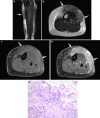Imaging features of primary sites and metastatic patterns of angiosarcoma
- PMID: 34921641
- PMCID: PMC8684573
- DOI: 10.1186/s13244-021-01129-9
Imaging features of primary sites and metastatic patterns of angiosarcoma
Abstract
Angiosarcomas are rare, aggressive soft tissue sarcomas originating from endothelial cells of lymphatic or vascular origin and associated with a poor prognosis. The clinical and imaging features of angiosarcomas are heterogeneous with a wide spectrum of findings involving any site of the body, but these most commonly present as cutaneous disease in the head and neck of elderly men. MRI and CT are complementary imaging techniques in assessing the extent of disease, focality and involvement of adjacent anatomical structures at the primary site of disease. CT plays an important role in the evaluation of metastatic disease. Given the wide range of imaging findings, correlation with clinical findings, specific risk factors and patterns of metastatic disease can help narrow the differential diagnosis. The final diagnosis should be confirmed with histopathology and immunohistochemistry in combination with clinical and imaging findings in a multidisciplinary setting with specialist sarcoma expertise. The purpose of this review is to describe the clinical and imaging features of primary sites and metastatic patterns of angiosarcomas utilising CT and MRI.
Keywords: Angiosarcoma; CT; MRI; Metastasis; Radiation.
© 2021. The Author(s).
Conflict of interest statement
RLJ is in receipt of grants/research support from MSD and GSK. RLJ is in receipt of consultation fees from Adaptimmune, Athenex, Bayer, Boehringer Ingelheim, Blueprint, Clinigen, Eisai, Epizyme, Daichii, Deciphera, Immunedesign, Lilly, Merck, Pharmamar, Springworks, Tracon & UpToDate.
Figures












References
Publication types
LinkOut - more resources
Full Text Sources

